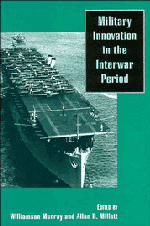Book contents
- Frontmatter
- Contents
- Acknowledgments
- Introduction
- 1 Armored warfare: The British, French, and German experiences
- 2 Assault from the sea: The development of amphibious warfare between the wars – the American, British, and Japanese experiences
- 3 Strategic bombing: The British, American, and German experiences
- 4 Close air support: The German, British, and American experiences, 1918–1941
- 5 Adopting the aircraft carrier: The British, American, and Japanese case studies
- 6 Innovation ignored: The submarine problem – Germany, Britain, and the United States, 1919–1939
- 7 From radio to radar: Interwar military adaptation to technological change in Germany, the United Kingdom, and the United States
- 8 Innovation: Past and future
- 9 Patterns of military innovation in the interwar period
- 10 Military innovation in peacetime
- Index
8 - Innovation: Past and future
Published online by Cambridge University Press: 05 August 2012
- Frontmatter
- Contents
- Acknowledgments
- Introduction
- 1 Armored warfare: The British, French, and German experiences
- 2 Assault from the sea: The development of amphibious warfare between the wars – the American, British, and Japanese experiences
- 3 Strategic bombing: The British, American, and German experiences
- 4 Close air support: The German, British, and American experiences, 1918–1941
- 5 Adopting the aircraft carrier: The British, American, and Japanese case studies
- 6 Innovation ignored: The submarine problem – Germany, Britain, and the United States, 1919–1939
- 7 From radio to radar: Interwar military adaptation to technological change in Germany, the United Kingdom, and the United States
- 8 Innovation: Past and future
- 9 Patterns of military innovation in the interwar period
- 10 Military innovation in peacetime
- Index
Summary
In 1991 the Soviet Union collapsed; with it went the military power and threat that had dominated so much of the history of the last half-century. As the “Wall” between occupation zones created in 1945 disappeared, so too paradigms for understanding the Cold War vanished in the echo of collapsing concrete. From a relatively simple and clear bi-polar contest between the United States and the Soviet Union, one sees the emergence of a multi-polar world of far more complexity. To add to uncertainties, in the late 1980s the military race between East and West had entered a period of considerable military innovation, occasioned by cascading changes in both civil and military technologies. What those changes mean or where they are going is not certain even in the aftermath of the Gulf War. Nothing, however, suggests that the rapid pace of innovation – underlined by the conduct of the war against Iraq – will not continue into the next century.
We appear therefore to be entering a time of political, strategic, and technological uncertainty; yet a period where the threats seem more indeterminate. Western military institutions confront a future in which they will not receive anything similar to the funding and resources they received throughout the Cold War despite rapid technological change and innovation. Thus, they must innovate with less money and greater ambiguities about potential opponents and the nature of the wars they will have to fight.
- Type
- Chapter
- Information
- Military Innovation in the Interwar Period , pp. 300 - 328Publisher: Cambridge University PressPrint publication year: 1996
- 7
- Cited by



